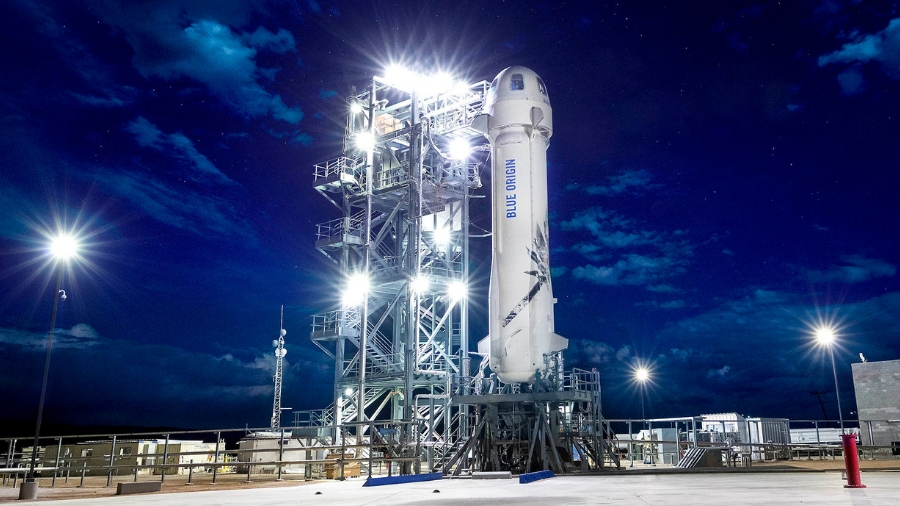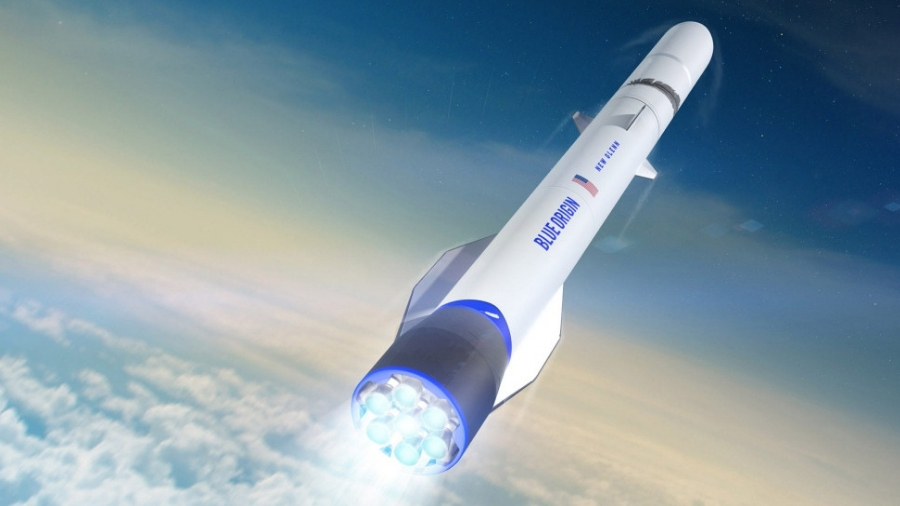Blue Origin: everything you need to know about the Amazon.com of space

Expensive, expendable rockets are history. Humanity's future is to take its heavy industry into space to protect Earth, and travel to space safely, reliably and affordably. That's what Blue Origin is all about.
What was once a secretive research company now has proven rocket launch systems and advanced plans to take commercial paying payloads and space tourists into space. Open for business, rapidly growing and quickly gaining commercial contracts, is Blue Origin on course to become the next Amazon.com of space?

What is Blue Origin and who owns it?
Blue Origin is an aerospace manufacturer founded in 2000 that's 100% privately funded by the richest man in the world. Jeff Bezos is the founder and CEO of Amazon.com, and owner of The Washington Post newspaper, and so far most of the accomplishments by Blue Origin have been funded by his own personal investment. According to the New York Times he sells $1 billion (about £800 million, AU$1.4 billion) of his own Amazon stock each year to finance Blue Origin.
Jeff Bezos got divorced from his wife MacKenzie in early 2019 and he was granted all of her interests in the Washington Post and Blue Origin, so there are no ownership issues.
Besides, Blue Origin is now rapidly gaining commercial contracts, so will be less dependent on the private investment of Bezos in the future. It’s also quickly expanding.

Where is Blue Origin based?
Blue Origin has a new HQ and R&D facility in Kent, Washington. However, its engineers oversee launches from a private suborbital launch and engine test site on Bezos' ranch just north of Van Horn, West Texas. However, it's now constructing an orbital launch facility at Cape Canaveral Air Force Station, Florida, with a rocket construction facility close by, and a $200 million (about £150, AU$300) rocket engine production facility in Huntsville, Alabama.
In April 2019 a deal was signed with NASA to allow Blue Origin to test its BE-3U and BE-4 liquefied natural gas rocket engines at NASA’s Marshall Space Flight Center also in Huntsville. The 300-foot-tall, vertical firing test stand 4670 was used by NASA in the 1960s to test the massive Saturn V rockets that took the Apollo spacecraft to the moon, as well as engines for the space shuttle.
Sign up for breaking news, reviews, opinion, top tech deals, and more.
A commitment by the US Air Force to use its super-rocket of the future called New Glenn (see below) means Blue Origin is looking into building a launch site at Vandenberg Air Force Base in California.
Blue Origin is going large and getting big, though it's got some way to go to reach the size of SpaceX.

What are Blue Origin's long-term goals?
Blue Origin's motto is gradatim ferociter, Latin for 'step by step, ferociously', but a clue to the company's long-term goals is in its name. The point of Blue Origin is to develop "technologies to enable human access to space at a dramatically lower cost and increased reliability," though Bezos has always been very clear that he doesn't think humanity should abandon Earth to go looking for a better home. Instead, he wants to see millions of people living and working in space, getting heavy industry and power generation off Earth, so that Earth can be preserved.
“We can harvest resources from asteroids, from Near-Earth Objects, and harvest solar energy from a much broader surface area – and continue to do amazing things,” he said in 2017. The alternative, he said, was an era of stasis and stagnation on Earth, where we are forced to control the population and limit energy usage per capita.
“I don’t think stasis is compatible with freedom or liberty, and I sure as hell think it’s going to be a very boring world – I want my grandchildren’s grandchildren to be in a world of pioneering, exploration and expansion throughout the solar system.”
Blue Origin is also interested in moon missions and is involved with the Moon Race project to boost the movement around Moon exploration.
Its first lunar lander, Blue Moon, was unveiled at an event in May 2019. The lander will come in two variations: one capable of carrying a 3.6 metric ton payload, and another able to carry 6.5 metric tons (the latter of which will be rated to carry people).
Blue Moon will be carried aboard the New Glenn rocket (see below), and its descent engine will be powered by liquid hydrogen, which Blue Origin ultimately hopes could be harvested from the moon's polar ice using electrolysis.

Blue Origin’s reusable New Shepard suborbital system
Blue Origin is a rocket-making company, and for now, it makes rockets that can reach space, but not orbit the Earth. That makes them ideal to take astronauts and research payloads past the internationally recognised boundary of space
A 60-foot. reusable sub-orbital rocket, New Shepard (named after Mercury astronaut Alan Shepard, the first American to go to space) is powered by a BE-3PM rocket engine. First flown in April 2015, New Shepard launches from a conventional launchpad, and a 12 ft. diameter crew capsule detaches and travels past the Kármán Line (62 miles/100km). It then parachutes back to Earth to be refurbished and reused.

Blue Origin and human spaceflight
It's important to appreciate that Blue Origin, as well as SpaceX and even Virgin Galactic, are not specifically space tourism companies, but it's probably going to be a good way to raise revenue for their bigger, off-planet ambitions.
So far Blue Origin has only sent 'Mannequin Skywalker' into space in New Shepard, but it has big and advanced plans for human spaceflight. In fact, its crew capsule is custom-made for observing Earth, with 43x29-inch windows alongside six reclining leather chairs.
Blue Origin now looks to be close to going live on space tourism after 10 missions, including a successful escape test in July 2018, when it fired the crew capsule escape motor at the highest altitude ever.

What will Blue Origin astronauts experience?
The 11-minute Blue Origin trip to the edge of space is going to be something akin to what Apollo astronauts experienced in the 1960s and 1970s on their missions to the moon. Six paying passengers will sit in the crew capsule on top of a New Shepard rocket. After a vertical launch, the engines will burn for two-and-a-half minutes and reach three times the speed of sound before the rockets and crew capsule detach from one another.
Those six passengers will keep going until they reach space, where they will enjoy three minutes of weightlessness while looking at the curvature of the Earth from space. They will then plummet to Earth before parachutes unfurl to take them slowly and safely back to the surface.
Blue Origin's Apollo-like vertical take-off, short-duration spaceflight trips makes it drastically different from what space tourists will experience with Virgin Galactic.

Does Blue Origin have any commercial contracts?
Yes – and they're coming in fast. After a long period as a secretive, privately funded research company with only a few small development contracts from NASA, Blue Origin is fully now out in the open, pitching for and winning large commercial contracts in the rocket launch business. That's a big deal for a company that needs to rapidly grow if it's going to achieve its goal of dramatically lowering launch costs.
In January 2019 it also worked under NASA's Flight Opportunities program, taking a cabin full of NASA payloads to space on its New Shepard mission (NS-10). In August 2018 Blue Origin signed a $10 million (about £8 million, AU$14 million) contract with NASA on developing a system for landing on the moon. Blue Origin will work on cryogenic liquid propulsion for a lunar lander-scaled integrated propulsion system; it could eventually mean a Blue Origin moon landing.
Blue Origin has also snagged a $500 million (about £400 million, AU$700 million) contract to develop its next-generation New Glenn rocket for the US Air Force. And in a further boost for development costs, two of its BE-4 rocket engines, now being designed for New Glenn, have been selected to power United Launch Alliance’s upcoming Vulcan rocket, due to fly in 2021.

Blue Origin's New Glenn orbital rocket
This is the big one designed to take people and payloads into orbit – and it’s already helping Blue Origin challenge the likes of SpaceX. A heavy-lift rocket due in 2021, the US$2.5 billion New Glenn (named after John Glenn, the first American to orbit the Earth, in 1962) will be a reusable rocket powered by seven BE-4 engines. With a combined thrust of nearly four million pounds, Blue Origin claims that New Glenn will carry twice as much cargo into space as any other launch provider in the market.
Despite it not even existing yet, the space industry is clearly interested. In January 2019 it was announced that New Glenn rockets will be used to launch Telesat’s broadband internet satellites into space, which will involve multiple rocket launches, while in October 2018 the US Air Force committed to using it (and Vulcan) for national security space (NSS) missions. Blue Origin also has launch deals with OneWeb, Eutelsat and muSpace on its books.
What's next for Blue Origin?
Though human spaceflight may soon begin on its New Shepard vehicle, the space race will truly begin when New Glenn starts flying. It's already a new era for Blue Origin. Now on the cusp of offering human spaceflight trips, getting more involved with NASA, and with money in the bank to expand and develop the next generation of heavy-lift orbital rockets, Blue Origin is ready to go places.

Jamie is a freelance tech, travel and space journalist based in the UK. He’s been writing regularly for Techradar since it was launched in 2008 and also writes regularly for Forbes, The Telegraph, the South China Morning Post, Sky & Telescope and the Sky At Night magazine as well as other Future titles T3, Digital Camera World, All About Space and Space.com. He also edits two of his own websites, TravGear.com and WhenIsTheNextEclipse.com that reflect his obsession with travel gear and solar eclipse travel. He is the author of A Stargazing Program For Beginners (Springer, 2015),